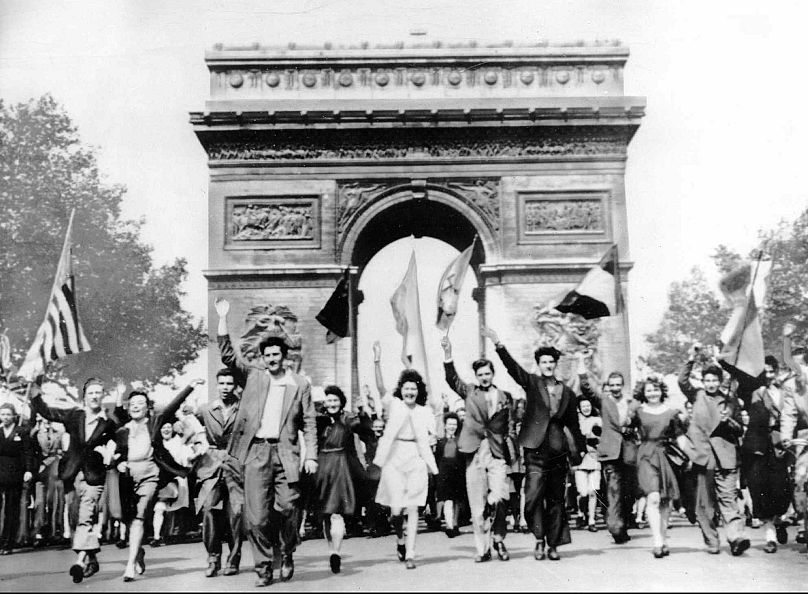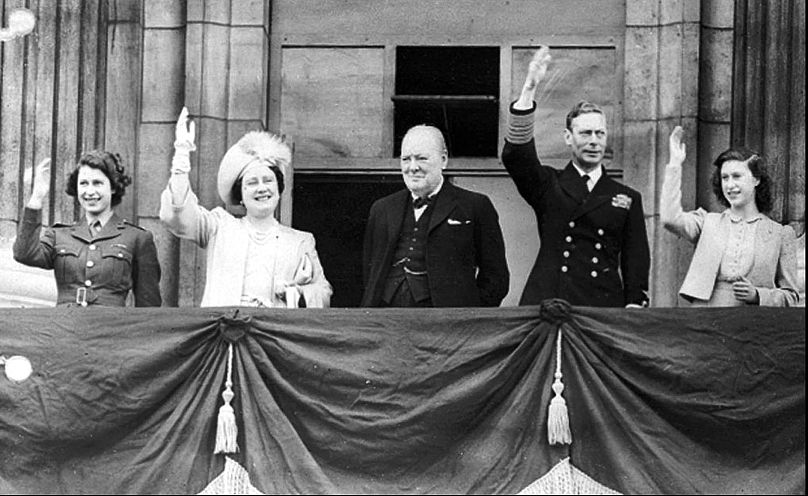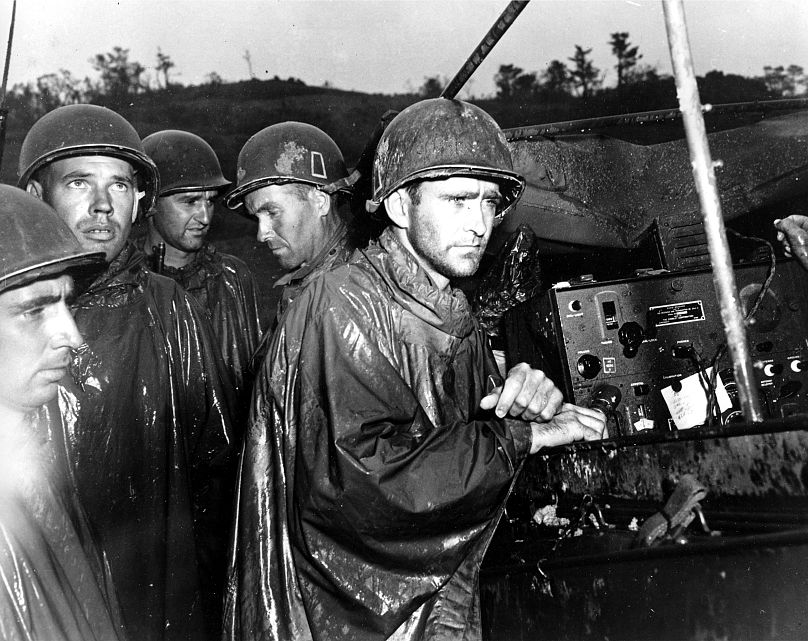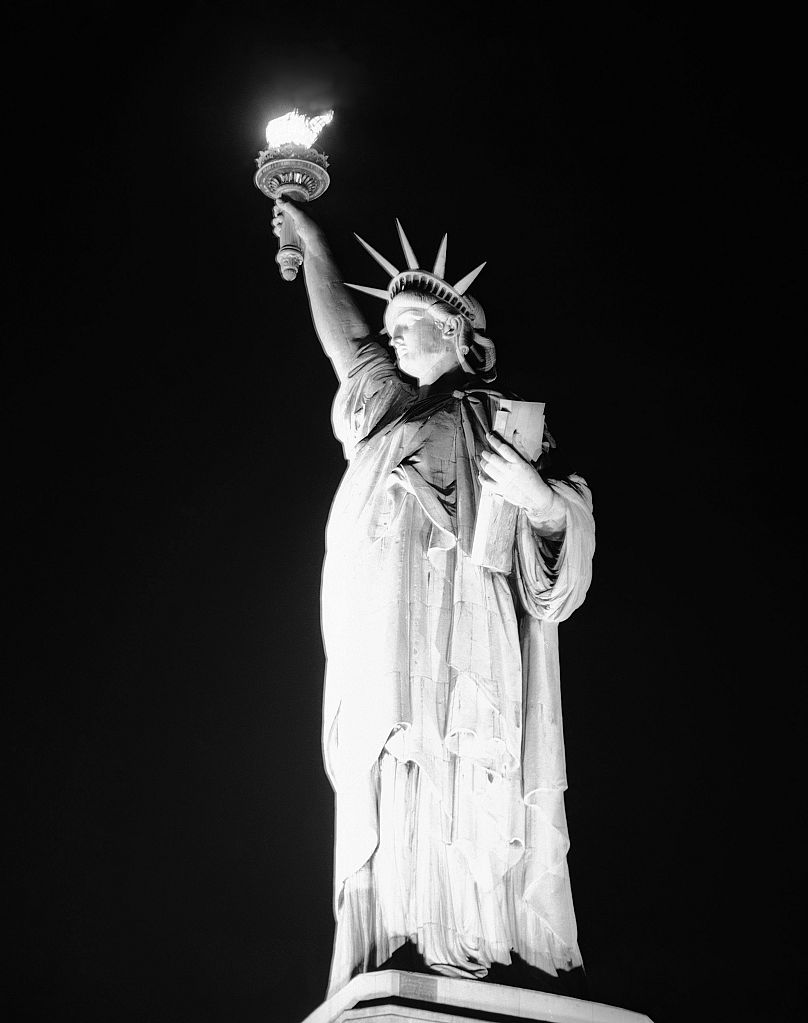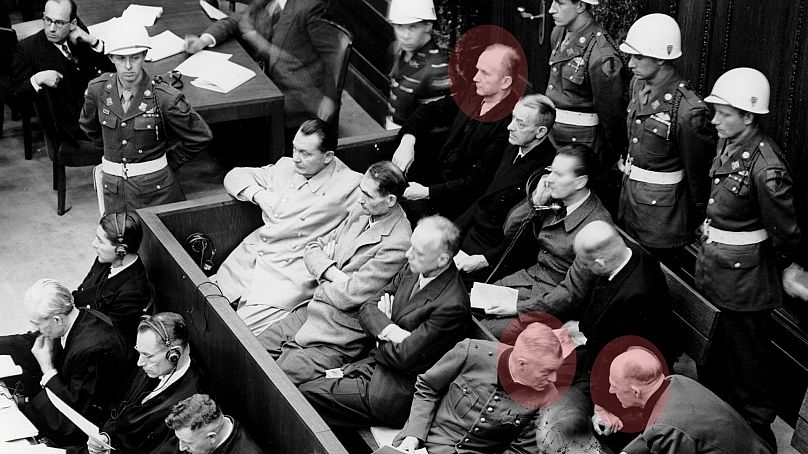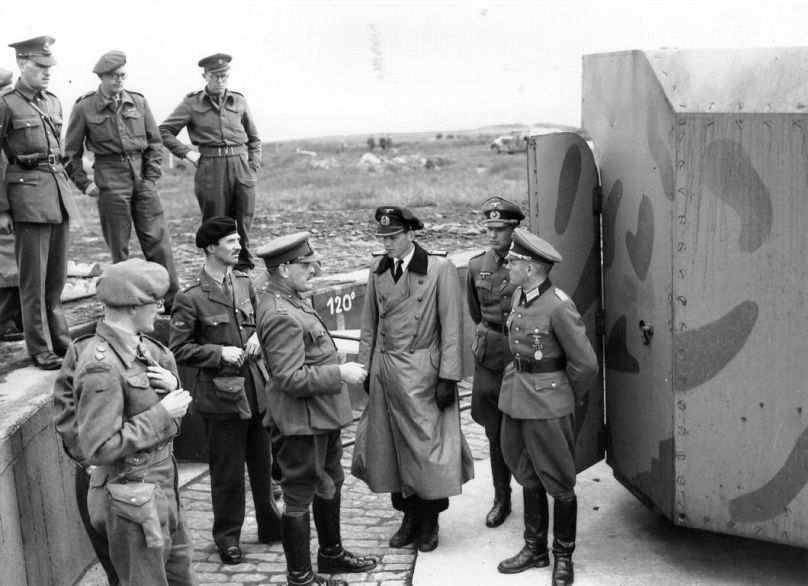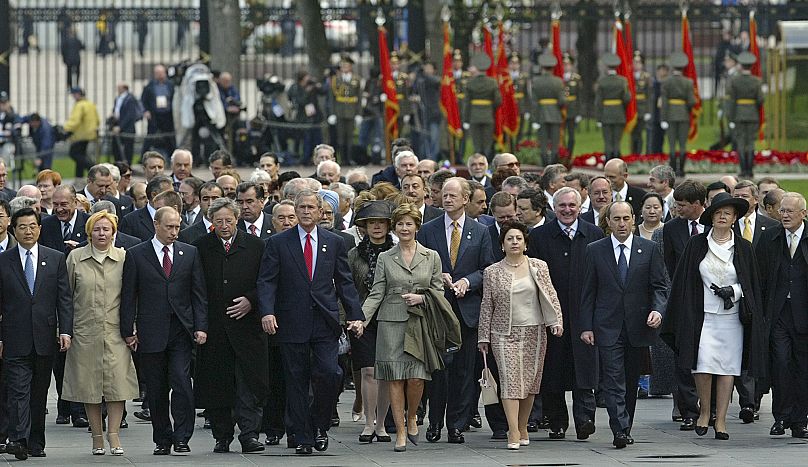Everything you wanted to know about Victory Day in Europe in seven facts.
The 78th anniversary of the defeat of Nazi Germany is being celebrated in countries across Europe, with national holidays to honour the occasion.
Victory in Europe Day marks the formal acceptance of Germany's unconditional surrender of its armed forces by the Allies, and the official end of World War II in Europe on the Eastern Front.
This year's event is proving to be controversial, with Russian President Vladimir Putin using the country's celebrations to claim that “a real war” has been unleashed against Russia, a reference to the war in Ukraine.
Meanwhile, in a break with its Soviet past, Ukraine shifted its commemoration of the defeat of Nazi Germany from 9 May - like Russia - to 8 May, Victory in Europe Day.
Here are seven things you may not know about Victory Day, from its different names, to why it's celebrated on different days in different countries.
1. A European holiday on different dates, with different names
Victory Day is celebrated in more than a dozen European countries in May, but not on the same date or under the same name.
The earliest celebrations take place in Denmark and the Netherlands on 5 May. It’s a public holiday in the latter and is known as Liberation Day in both. Norway celebrates its own version of Liberation Day on 8 May.
This is also the date chosen by the three Baltic countries, but they call it Remembrance Day.
In France, 8 May is Victory in Europe Day and a national holiday. The UK opts for the same date and abbreviates it to VE Day, and 9 May is Liberation Day in Jersey.
Poland recently changed the date from 9 May to 8 May, so it's been celebrating National Victory Day since 2015. Before the change, it celebrated like other socialist states and Russia.
Russia has celebrated Victory Day on 9 May every year except for the very first one, and since then it’s become one of the country’s most important holidays. It puts on an enormous military parade, symbolising the country’s desire to strengthen bonds within its borders and a show of warning to any potential enemies on the outside.
The reason behind these different dates is politics. After Adolf Hitler’s suicide on 30 April, it was clear that the fight wouldn’t last much longer. Joseph Stalin, leader of the Soviet Union, was attacking from the east and only wanted to accept an unconditional and immediate total surrender. But the Western allies were less eager to stick to their guns. One of the reasons for this was that UK Prime Minister Winston Churchill saw the Soviet army advancing ever westward as an effort to gain more territories - showing a lack of respect for the demarcation lines drawn up during the Yalta conference.
When Karl Dönitz (who was named head of state after Hitler’s death) offered partial capitulation (in north-west Germany, Denmark and the Netherlands), Churchill immediately accepted. This is how an initial surrender occurred on 4 May 1945, signed by Field Marshal Bernard Law Montgomery on the Allied side. It came into effect the day after.
Stalin was angry, not only because of the news of partial capitulation but also because he had seen German forces fighting the Soviets to the bitter end in the east while they surrendered en masse to his Western allies.
The Soviet leader's fury increased when he heard that Commander General Eisenhower had accepted the unconditional surrender of all German forces on 7 May in Reims, France.
Stalin insisted on a capitulation ceremony in Berlin - at the heart of Nazi Germany - the day after. It came into effect at 23:01 on 8 May, which was already the following day in Russia.
2. Marking the end of World War II in Europe but not the war itself
After Nazi Germany’s surrender, Europe breathed a sigh of relief, but unfortunately, it did not mean the end of the war.
As King George VI of the United Kingdom said in his radio speech announcing the European victory:
“The enemy who drove all Europe into war has been finally overcome. In the Far East, we have yet to deal with the Japanese, a determined and cruel foe”.
The allied troops fought on, and later that month they conquered Okinawa, which was the last island stop before the Japanese mainland.
On 6 August, the United States dropped an atomic bomb on Hiroshima, and another on Nagasaki three days later. Japan formally surrendered on 14 August and World War II ended, with millions more falling victim to the conflict after the European celebrations on 8 May.
3. Somber celebrations in the US following Roosevelt’s death
In the United States, Victory in Europe Day was celebrated with less enthusiasm for obvious reasons, one of which was that the war was still going on.
But the Americans were also still in mourning: President Franklin D. Roosevelt had died less than a month before. The politician was elected four times as president (which is a record) and is one of the most important figures in 20th-century American history. The 63-year-old politician was sitting for a portrait when he suddenly complained of a terrible headache and lost consciousness before being killed by a stroke. His funeral procession on 14 April in Washington, D.C. was watched by 300.000 spectators.
Roosevelt was succeeded by Harry Truman, who ordered the flags to be kept at half-mast on 8 May and dedicated the Victory in Europe celebrations to his predecessor.
4. Some European countries have never celebrated the end of the war because their suffering didn’t stop there
For many eastern European countries, which were liberated from Nazi Germany by Soviet troops, the end of the war marked the beginning of a new, era under Soviet influence. Most of them only saw the Soviets leave their land decades later when the USSR was about to collapse, bringing in another regime change without violence.
The end of the armed conflict also paved the way for what came next: the crumbling of the alliance and the mistrust that festered between the Western and Soviet leaders. this led to the building of the Iron Curtain, dividing Europe between the East and West, and the start of the Cold War between Western countries and the Soviet Union (and its allies).
For this reason, some European countries don’t celebrate the end of WWII or even hold a ceremony to acknowledge the day that brought an end to the conflict on the continent. It also explains why Poland felt it was important to change the date of its celebration to align with Western countries instead of Russia.
5. Convictions, executions and jail sentences
Admiral Karl Dönitz was named President of Germany in accordance with Hitler’s last political will. One of the reasons behind this choice might be that no naval officers took part in the failed attempt to assassinate the Führer in July 1944.
According to Dönitz though, he was chosen because Hitler felt "doubtlessly, that only a reasonable man with an honest reputation as a sailor could make a decent peace". Dönitz’s main concern was getting as many German soldiers as possible to surrender to Western forces rather than the Soviets, because he knew what Soviet captivity would mean for his soldiers.
It might be surprising that Dönitz, the only leader of Nazi Germany to survive the war, was not executed. Rather, he was sentenced to ten years in prison. He died at the age of 89 in 1980, in a small village in West Germany.
Colonel General Alfred Jodl, who signed the surrender on behalf of Germany in Reims on 7 May, was found guilty of several serious crimes in Nuremberg, including supporting the use of slave labour in concentration camps and targeting civilian populations in both Russia and Norway. He was sentenced to death and executed in Nuremberg on 16 October 1946.
Field Marshal Wilhelm Keitel was executed on the same day. He was the Supreme Commander of the German Armed Forces and also signed the surrender agreement in Berlin. During the Nuremberg trials, he was found to be complicit in the mass atrocities and war crimes committed in the name of the Third Reich, including the genocide of Jews. He signed the two orders: The Night and Fog Decree and the Commando Order. The first approved the murder of thousands of resistance fighters and the latter, the killing of allied special operation troops, even if they were captured in uniform.
6. Not all the German forces were made aware of the surrender
The news of surrender didn’t spread to all members of the German forces. There were some isolated units who kept on fighting in Norway and Denmark, but the most extreme case concerns a weather station crew, who officially surrendered some weeks after the Japanese formally stopped fighting.
It took time for allies to liberate every corner of Europe, such as Alderney - the most isolated and northernmost of the Channel Islands - which was taken back by the soldiers of UK Task Force 135 on 16 May.
They met no resistance from the German soldiers on the completely deserted island - the locals were evacuated on 30 June 1940 before the Nazis arrived. The next seven months saw the British soldiers and the German prisoners working together to prepare the island for the return of its population, by clearing minefields, rebuilding houses and restoring churches.
The longest “serving” German unit was a crew of a weather station on Nordaustlandet, one of the most remote northern islands in Svalbard, Norway. It was set up in September 1944 with a crew of 11 people, under the name Operation Haudegen. Their task was to transmit encrypted weather forecasts five times a day to the German naval command in Tromsø. They received a message on 8 May 1945 from their commanders saying that Germany had surrendered and the war was over. They were told to destroy secret documents, but not much more than that. After trying to recontact their base in vain, they attempted to transmit their coordinates to the allies to avoid being left alone in the cold.
They finally got an answer at the end of August, when the Norwegian navy sent out a seal-hunting ship which arrived at the station on the night of 3 September. The Norwegians and the Germans, who were happy to finally be able to surrender, shared a meal together, during which the German commanding officer handed over his service pistol to the seal-hunter ship’s captain. The 11-man unit spent three months in Tromsø together but were ultimately split up when some got sent to East Germany and others to the West.
7. Russia’s Victory Day on 9 May became one of its most important holidays
Russia’s first victory parade was on 24 June 1945. Stalin gave the starring role to Marshal Zhukov, who accepted the parade at the Red Square in Moscow, where he arrived on a white horse rather than in a car. The parade ended with 200 soldiers carrying Nazi flags and banners, throwing them on the ground at the Lenin Mausoleum pedestal and destroying them.
This symbolic gesture showed that for the Soviets, the day marked not only the end of the war but also their victory over Nazism. This is also why there is so much speculation over what President Vladimir Putin will do for this year’s parade, as the Kremlin has justified its so-called “military operation” in Ukraine as an attempt to destroy the alleged neo-Nazis in the country.
Until 1995, the parade was held only on jubilee years. It was President Boris Yeltsin who made it an annual event.
Over the years, Moscow has welcomed hundreds of foreign leaders and politicians to celebrate Victory Day, with the biggest parade taking place in 2005: over 150 foreign dignitaries, including 50 heads of state, gathered in the capital to celebrate the 60th anniversary of the victory over Nazi Germany.












